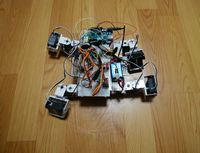str/list/set/dictのオブジェクトとファイル操作 [Pythonの基本]
Python/TensorFlowの使い方(目次)
目次
1. strオブジェクト
2. listオブジェクト
3. setオブジェクト
4. dictオブジェクト
5. ファイル操作
1. strオブジェクト
>>> 'Py' in 'Python'
True
>>> "プチモンテ".replace("モンテ", "ラボ")
プチラボ
| メソッド | 内容 |
|---|
| str.replace(old, new[, count]) | 文字列を置換して返す。 |
| str.find(sub[, start[, end]]) | 文字列を検索してインデックスを返す。 |
| str.rfind(sub[, start[, end]]) | 文字列を検索して最大インデックスを返す。 |
| str.index(sub[, start[, end]]) | findと同様。存在しない場合はValueError。 |
| str.rindex(sub[, start[, end]]) | rfindと同様。存在しない場合はValueError。 |
| str.startswith(prefix[, start[, end]]) | 文字列が指定文字から始まるならばTrue。 |
| str.endswith(suffix[, start[, end]]) | 文字列が指定文字で終わるならばTrue。 |
| メソッド | 内容 |
|---|
| str.count(sub[, start[, end]]) | 指定された文字が出現する回数を返す。 |
| メソッド | 内容 |
|---|
| str.lower() | 文字列を小文字にして返す。 |
| str.upper() | 文字列を大文字にして返す。 |
| メソッド | 内容 |
|---|
| str.strip([chars]) | 文字列の前後の指定文字を削除して返す。 |
| メソッド | 内容 |
|---|
| str.split(sep=None, maxsplit=-1) | 指定文字で区切った単語のリストを返す。
>>> "1,2,3".split(',')
['1', '2', '3']
|
| メソッド | 内容 |
|---|
| str.join(iterable) | 文字列を結合して返す。
>>> ",".join("123")
1,2,3
|
| メソッド | 内容 |
|---|
| str.isalpha() | 文字列が英字であればTrue。 |
| str.isalnum() | 文字列が英数字であればTrue。 |
| str.isdigit() | 文字列が数字であればTrue。 |
| str.isdecimal() | 文字列が十進数字であればTrue。 |
| str.isnumeric() | 文字列が数を表す文字であればTrue。 |
| islower() | 文字列が小文字であればTrue。 |
| isupper() | 文字列が大文字であればTrue。 |
| メソッド | 内容 |
|---|
| str.center(width[, fillchar]) | 文字列を中央寄せして返す。 |
| str.ljust(width[, fillchar]) | 文字列を左寄せして返す。 |
| str.rjust(width[, fillchar]) | 文字列を右寄せして返す。 |
| メソッド | 内容 |
|---|
| str.format(*args, **kwargs) | 文字列の書式化操作を行い返す。
>>> "{}".format("プチモンテ")
プチモンテ
>>> "{0}{1}{2}".format("プチ","と","モンテ")
プチとモンテ
>>> "{a1}{a3}{a2}".format(a1='a', a2='c', a3='b')
abc
>>> dic = {'a1':'a', 'a2':'b', 'a3':'c'}
>>> "{0[a1]}{0[a2]}{0[a3]}".format(dic)
abc
>>> "{:.2%}".format(3/5)
60.00%
>>> "{:,}".format(1000)
1,000
>>> "{0:10} {1:>}".format('プチ', 100)
プチ 100
|
2. listオブジェクト
>>> list("12345")
['1', '2', '3', '4', '5']
>>> list("abcde")
['a', 'b', 'c', 'd', 'e']
>>> lst =[1,2,3,4,5]
>>> lst[2:4] = ['a','b','c']
>>> lst
[1, 2, 'a', 'b', 'c', 5]
| メソッド | 内容 |
|---|
| list.append(x) | xを最後に追加する。 |
| list.clear() | 全ての要素を削除する。 |
| list.insert(i, x) | i番目にxを追加する。 |
| list.pop([i]) | i番目の要素を返しリストから削除する。 |
| list.remove(x) | i番目の要素を削除する |
| list.reverse() | 要素の順番を反対にする。 |
| sort(*, key=None, reverse=False) | リストの要素をソートする。
>>> lst =[3,1,4,2,5]
>>> lst.sort()
>>> lst
[1, 2, 3, 4, 5]
>>> lst =[3,1,4,2,5]
>>> lst.sort(reverse = True)
>>> lst
[5, 4, 3, 2, 1]
|
3. setオブジェクト
>>> set([1, 2, 2, 3, 4, 5])
{1, 2, 3, 4, 5}
>>> {2, 4} <= {1, 2, 3, 4, 5}
True
>>> {2, 4} >= {1, 2, 3, 4, 5}
False
| メソッド | 内容 |
|---|
| set.union(*others) | 和集合(OR) |
| set.intersection(*others) | 交わり(AND) |
| set.difference(*others) | 差集合(-) |
| set.symmetric_difference(other) | 対称差(XOR) |
| メソッド | 内容 |
|---|
| set.add(elem) | 要素を追加する。 |
| set.remove(elem) | 要素を削除する。存在しない場合はKeyErrorとなる。 |
| set.discard(elem) | 指定した要素を削除する。 |
| set.pop() | 最初の要素を返し、setから削除する。 |
| set.clear() | 全ての要素を削除する。 |
4. dictオブジェクト
>>> dict(a=1 ,b=2,c=3)
{'a': 1, 'b': 2, 'c': 3}
>>> dict(zip(['a', 'b', 'c'], [1, 2, 3]))
{'a': 1, 'b': 2, 'c': 3}
>>> dic = {'a': 1, 'b': 2, 'c': 3}
>>> del dic['b']
>>> dic
{'a': 1, 'c': 3}
| メソッド | 内容 |
|---|
| dict.clear() | 全ての辞書を削除する。 |
| dict.get(key[, default]) | 辞書の値を取得する。 |
| dict.items() | 辞書を返す。 |
| dict.keys() | 辞書のキーを返す。 |
| dict.pop(key[, default]) | 辞書のキーの値を返し、辞書から削除する。 |
| dict.values() | 辞書の値を返す。 |
5. ファイル操作
[ファイルの作成]
try:
f = open("無題.txt", "w", encoding="utf-8")
f.write("プチモンテ\nhttps://www.petitmonte.com/")
except:
print("エラーが発生しました。")
finally:
f.close()
[ファイルの読み込み]
try:
f = open("無題.txt", "r", encoding="utf-8")
print(f.read())
except:
print("エラーが発生しました。")
finally:
f.close()
関連記事
公開日:2018年06月30日 最終更新日:2018年08月24日

プチモンテ ※この記事を書いた人
 |
 | 💻 ITスキル・経験
サーバー構築からWebアプリケーション開発。IoTをはじめとする電子工作、ロボット、人工知能やスマホ/OSアプリまで分野問わず経験。
画像処理/音声処理/アニメーション、3Dゲーム、会計ソフト、PDF作成/編集、逆アセンブラ、EXE/DLLファイルの書き換えなどのアプリを公開。詳しくは自己紹介へ
|
🎵 音楽制作
BGMは楽器(音源)さえあれば、何でも制作可能。歌モノは主にロック、バラード、ポップスを制作。歌詞は抒情詩、抒情的な楽曲が多い。楽曲制作は🔰2023年12月中旬 ~ |
オリジナル曲を始めました✨
背徳の遊牧民 feat. オペラさん (2025/9/1 新曲)













